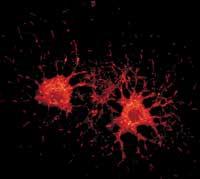Human cells can resolve the spinal cord of rats
2001/02/26 Galarraga Aiestaran, Ana - Elhuyar Zientzia

To quickly carry electrical stimuli through the body, nerve fibers are surrounded by a tissue called myelin. Although scientists do not know the origin of multiple sclerosis, it is known that in patients with multiple sclerosis the myelin of the brain and spinal cord gradually weakens, so nerve stimuli move more slowly or remain completely. Symptoms may come from loss of balance to paralysis.
In the study of multiple sclerosis, scientists at Yale University of Connecticut (USA) used rats in which they were partially removed from the spinal cord myelin. On the other hand, Shwann cells that form myelin were taken from a human leg amputated and transplanted into the spinal cord of rats. They inhibited the immune system of animals to prevent rejection.
In addition to multiplying the transplanted cells and filling the ranges of the myelin layer, the conduction of nerve stimuli reached the usual level. This, using the patient's cells, awakens the hope of being able to fix their loss of myelin.
However, researchers still do not know if Shwann cells can repair human myelin like rats. In the coming months, human testing is expected, and other research on this issue will certainly be released.

Gai honi buruzko eduki gehiago
Elhuyarrek garatutako teknologia






